University Financial Management Report: BMP3005, Semester 2
VerifiedAdded on 2022/12/27
|14
|2888
|23
Report
AI Summary
This report delves into the critical role of financial management in business, encompassing its definition, core concepts, and overall importance. It examines key financial statements, including income statements, balance sheets, and cash flow statements, while also explaining the use of financial ratios for performance evaluation. The report provides a comprehensive review of business performance, focusing on profitability, liquidity, and efficiency ratios, offering a detailed analysis. Furthermore, it outlines processes and strategies that businesses can implement to enhance their financial performance, such as effective capital budgeting, working capital management, and marketing strategies to increase revenue and reduce costs, supported by management accounting techniques and tools. The report concludes by emphasizing the significance of financial management in informed decision-making and overall business success.
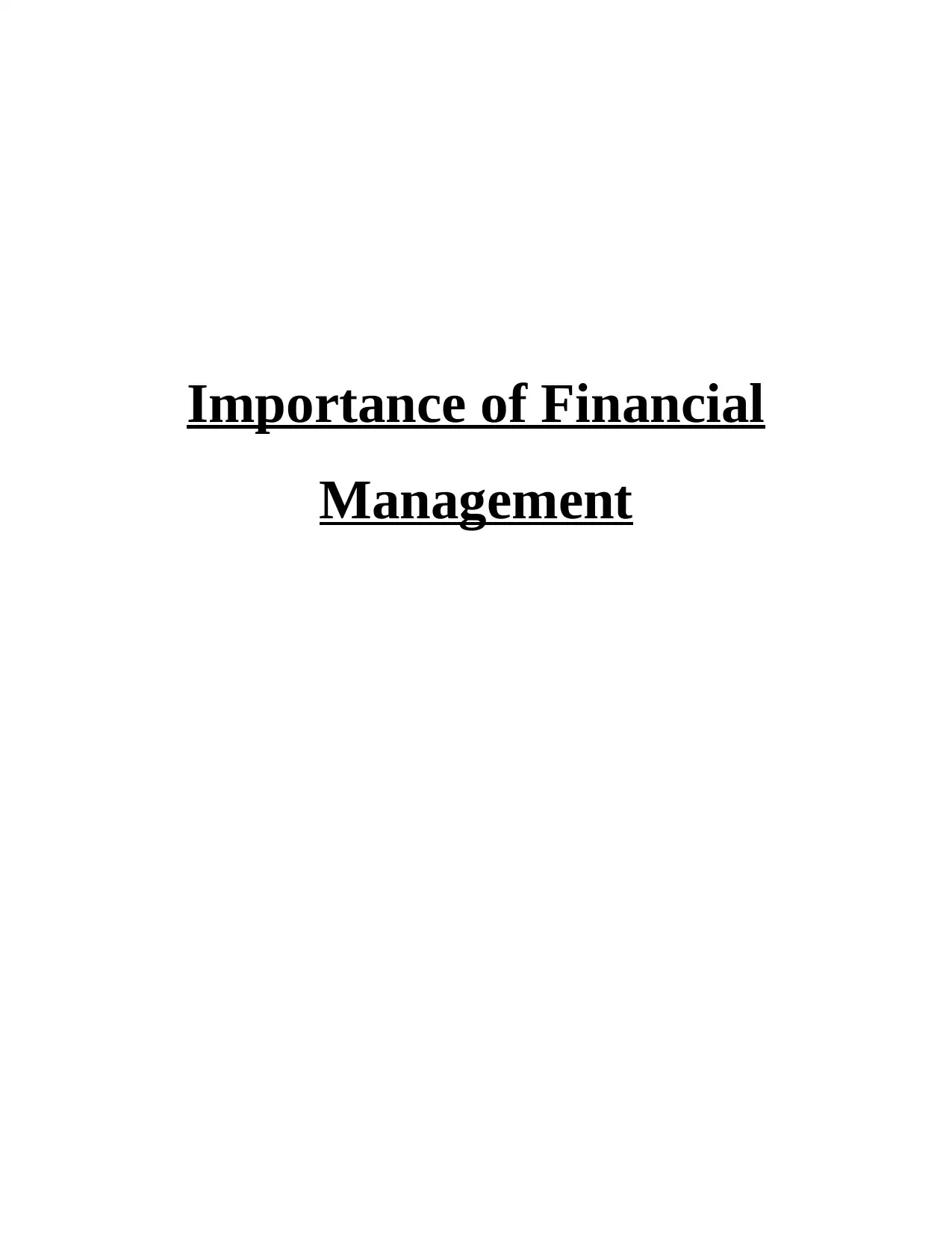
Importance of Financial
Management
Management
Paraphrase This Document
Need a fresh take? Get an instant paraphrase of this document with our AI Paraphraser
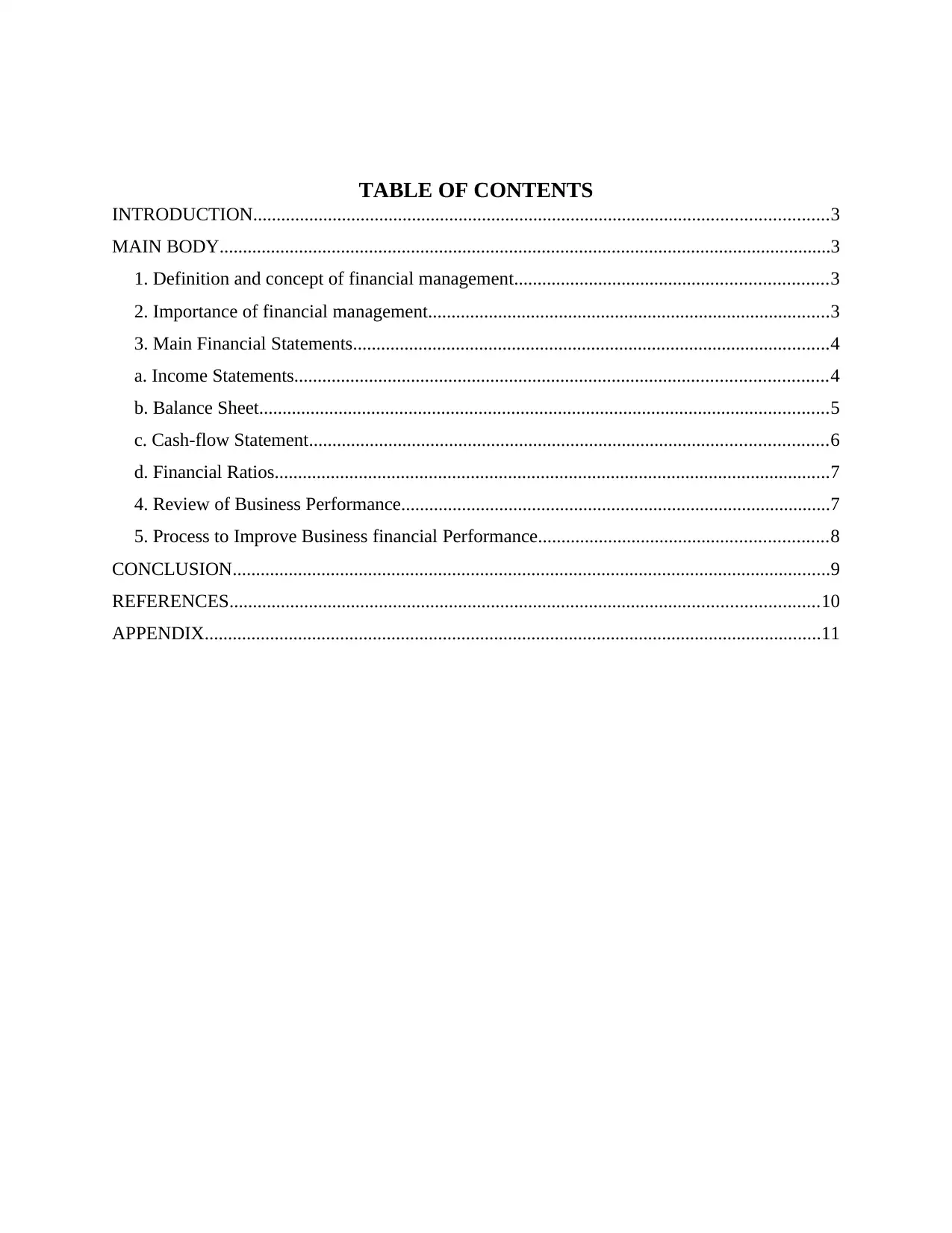
TABLE OF CONTENTS
INTRODUCTION...........................................................................................................................3
MAIN BODY...................................................................................................................................3
1. Definition and concept of financial management...................................................................3
2. Importance of financial management......................................................................................3
3. Main Financial Statements......................................................................................................4
a. Income Statements..................................................................................................................4
b. Balance Sheet..........................................................................................................................5
c. Cash-flow Statement...............................................................................................................6
d. Financial Ratios.......................................................................................................................7
4. Review of Business Performance............................................................................................7
5. Process to Improve Business financial Performance..............................................................8
CONCLUSION................................................................................................................................9
REFERENCES..............................................................................................................................10
APPENDIX....................................................................................................................................11
INTRODUCTION...........................................................................................................................3
MAIN BODY...................................................................................................................................3
1. Definition and concept of financial management...................................................................3
2. Importance of financial management......................................................................................3
3. Main Financial Statements......................................................................................................4
a. Income Statements..................................................................................................................4
b. Balance Sheet..........................................................................................................................5
c. Cash-flow Statement...............................................................................................................6
d. Financial Ratios.......................................................................................................................7
4. Review of Business Performance............................................................................................7
5. Process to Improve Business financial Performance..............................................................8
CONCLUSION................................................................................................................................9
REFERENCES..............................................................................................................................10
APPENDIX....................................................................................................................................11
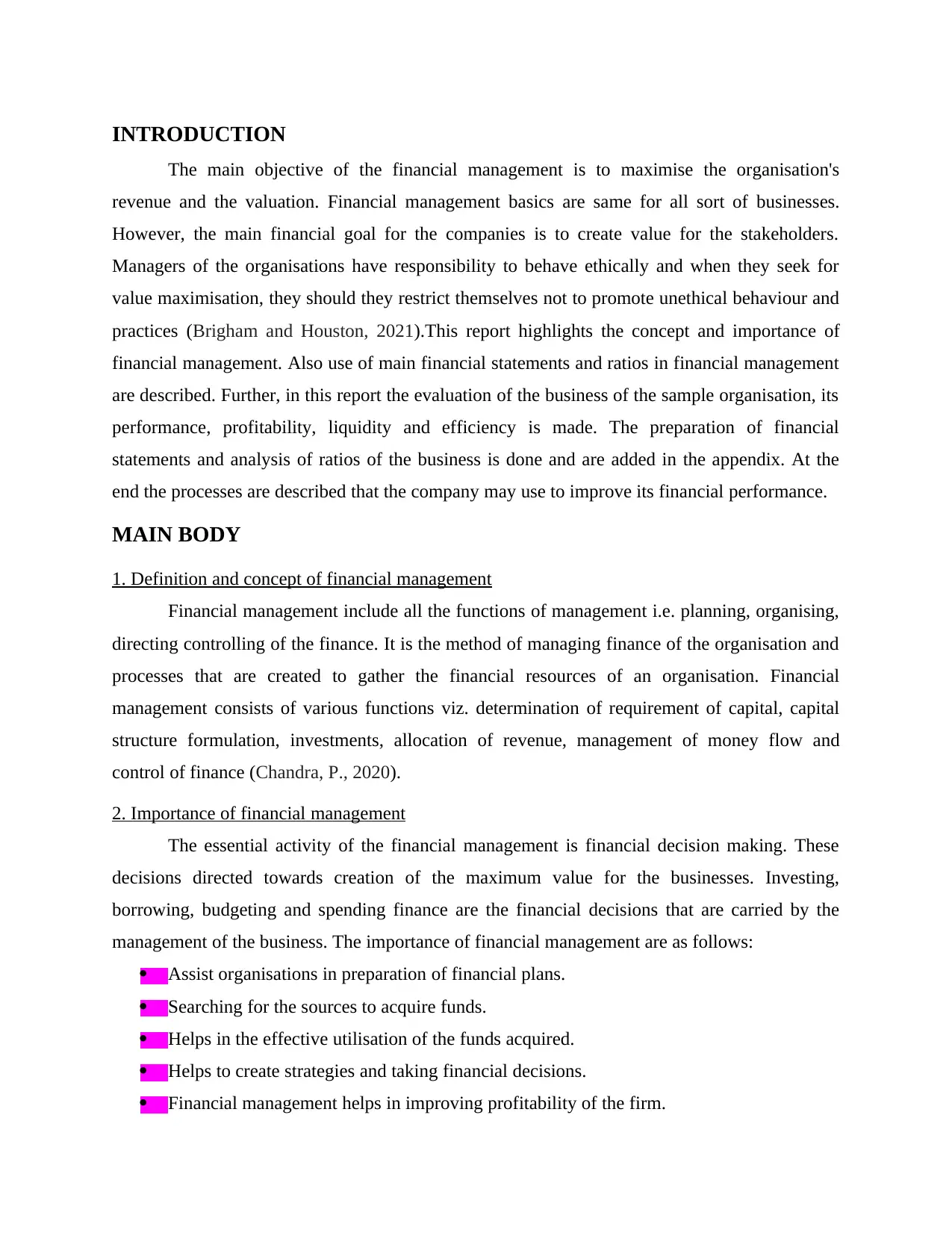
INTRODUCTION
The main objective of the financial management is to maximise the organisation's
revenue and the valuation. Financial management basics are same for all sort of businesses.
However, the main financial goal for the companies is to create value for the stakeholders.
Managers of the organisations have responsibility to behave ethically and when they seek for
value maximisation, they should they restrict themselves not to promote unethical behaviour and
practices (Brigham and Houston, 2021).This report highlights the concept and importance of
financial management. Also use of main financial statements and ratios in financial management
are described. Further, in this report the evaluation of the business of the sample organisation, its
performance, profitability, liquidity and efficiency is made. The preparation of financial
statements and analysis of ratios of the business is done and are added in the appendix. At the
end the processes are described that the company may use to improve its financial performance.
MAIN BODY
1. Definition and concept of financial management
Financial management include all the functions of management i.e. planning, organising,
directing controlling of the finance. It is the method of managing finance of the organisation and
processes that are created to gather the financial resources of an organisation. Financial
management consists of various functions viz. determination of requirement of capital, capital
structure formulation, investments, allocation of revenue, management of money flow and
control of finance (Chandra, P., 2020).
2. Importance of financial management
The essential activity of the financial management is financial decision making. These
decisions directed towards creation of the maximum value for the businesses. Investing,
borrowing, budgeting and spending finance are the financial decisions that are carried by the
management of the business. The importance of financial management are as follows:
Assist organisations in preparation of financial plans.
Searching for the sources to acquire funds.
Helps in the effective utilisation of the funds acquired.
Helps to create strategies and taking financial decisions.
Financial management helps in improving profitability of the firm.
The main objective of the financial management is to maximise the organisation's
revenue and the valuation. Financial management basics are same for all sort of businesses.
However, the main financial goal for the companies is to create value for the stakeholders.
Managers of the organisations have responsibility to behave ethically and when they seek for
value maximisation, they should they restrict themselves not to promote unethical behaviour and
practices (Brigham and Houston, 2021).This report highlights the concept and importance of
financial management. Also use of main financial statements and ratios in financial management
are described. Further, in this report the evaluation of the business of the sample organisation, its
performance, profitability, liquidity and efficiency is made. The preparation of financial
statements and analysis of ratios of the business is done and are added in the appendix. At the
end the processes are described that the company may use to improve its financial performance.
MAIN BODY
1. Definition and concept of financial management
Financial management include all the functions of management i.e. planning, organising,
directing controlling of the finance. It is the method of managing finance of the organisation and
processes that are created to gather the financial resources of an organisation. Financial
management consists of various functions viz. determination of requirement of capital, capital
structure formulation, investments, allocation of revenue, management of money flow and
control of finance (Chandra, P., 2020).
2. Importance of financial management
The essential activity of the financial management is financial decision making. These
decisions directed towards creation of the maximum value for the businesses. Investing,
borrowing, budgeting and spending finance are the financial decisions that are carried by the
management of the business. The importance of financial management are as follows:
Assist organisations in preparation of financial plans.
Searching for the sources to acquire funds.
Helps in the effective utilisation of the funds acquired.
Helps to create strategies and taking financial decisions.
Financial management helps in improving profitability of the firm.
⊘ This is a preview!⊘
Do you want full access?
Subscribe today to unlock all pages.

Trusted by 1+ million students worldwide
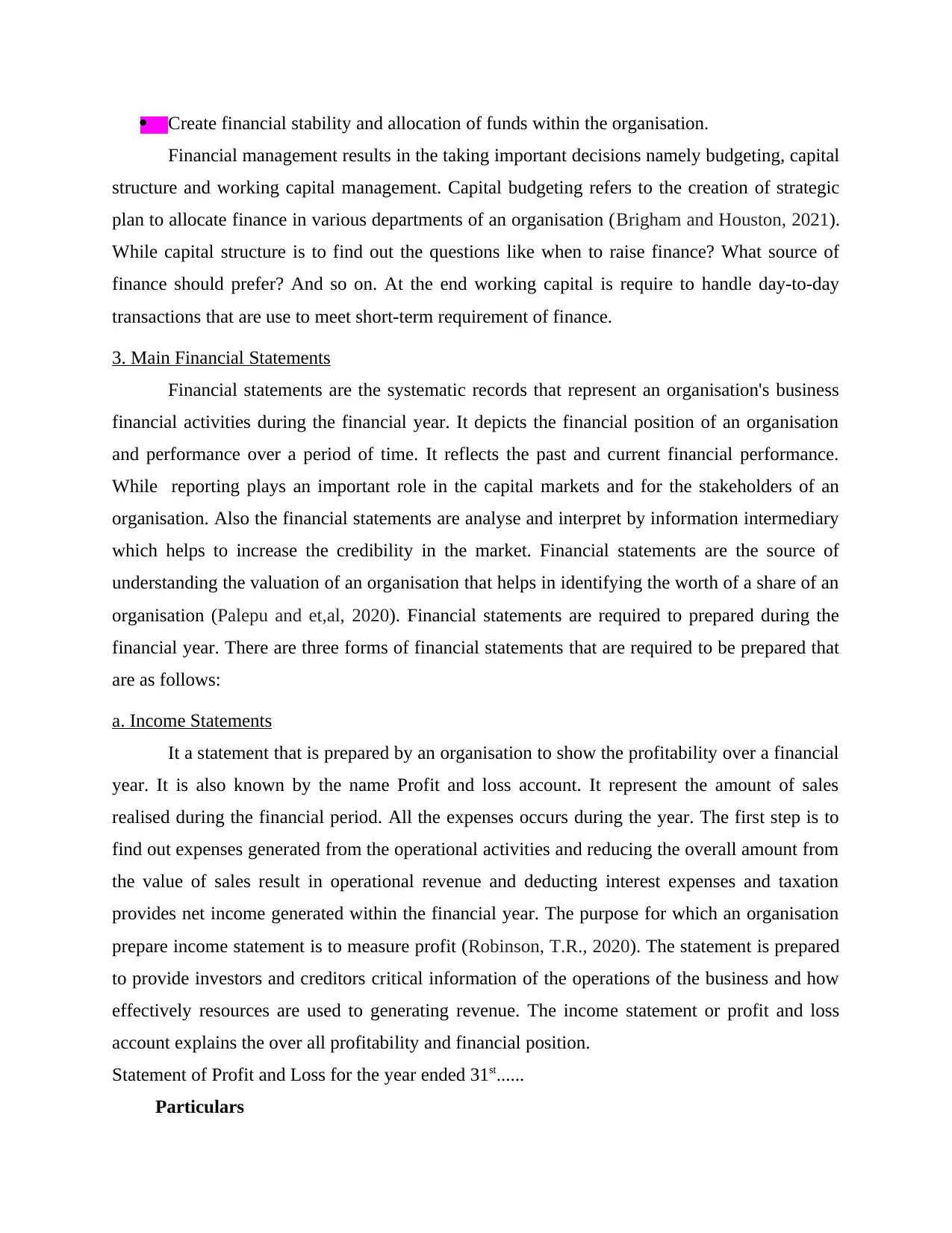
Create financial stability and allocation of funds within the organisation.
Financial management results in the taking important decisions namely budgeting, capital
structure and working capital management. Capital budgeting refers to the creation of strategic
plan to allocate finance in various departments of an organisation (Brigham and Houston, 2021).
While capital structure is to find out the questions like when to raise finance? What source of
finance should prefer? And so on. At the end working capital is require to handle day-to-day
transactions that are use to meet short-term requirement of finance.
3. Main Financial Statements
Financial statements are the systematic records that represent an organisation's business
financial activities during the financial year. It depicts the financial position of an organisation
and performance over a period of time. It reflects the past and current financial performance.
While reporting plays an important role in the capital markets and for the stakeholders of an
organisation. Also the financial statements are analyse and interpret by information intermediary
which helps to increase the credibility in the market. Financial statements are the source of
understanding the valuation of an organisation that helps in identifying the worth of a share of an
organisation (Palepu and et,al, 2020). Financial statements are required to prepared during the
financial year. There are three forms of financial statements that are required to be prepared that
are as follows:
a. Income Statements
It a statement that is prepared by an organisation to show the profitability over a financial
year. It is also known by the name Profit and loss account. It represent the amount of sales
realised during the financial period. All the expenses occurs during the year. The first step is to
find out expenses generated from the operational activities and reducing the overall amount from
the value of sales result in operational revenue and deducting interest expenses and taxation
provides net income generated within the financial year. The purpose for which an organisation
prepare income statement is to measure profit (Robinson, T.R., 2020). The statement is prepared
to provide investors and creditors critical information of the operations of the business and how
effectively resources are used to generating revenue. The income statement or profit and loss
account explains the over all profitability and financial position.
Statement of Profit and Loss for the year ended 31st......
Particulars
Financial management results in the taking important decisions namely budgeting, capital
structure and working capital management. Capital budgeting refers to the creation of strategic
plan to allocate finance in various departments of an organisation (Brigham and Houston, 2021).
While capital structure is to find out the questions like when to raise finance? What source of
finance should prefer? And so on. At the end working capital is require to handle day-to-day
transactions that are use to meet short-term requirement of finance.
3. Main Financial Statements
Financial statements are the systematic records that represent an organisation's business
financial activities during the financial year. It depicts the financial position of an organisation
and performance over a period of time. It reflects the past and current financial performance.
While reporting plays an important role in the capital markets and for the stakeholders of an
organisation. Also the financial statements are analyse and interpret by information intermediary
which helps to increase the credibility in the market. Financial statements are the source of
understanding the valuation of an organisation that helps in identifying the worth of a share of an
organisation (Palepu and et,al, 2020). Financial statements are required to prepared during the
financial year. There are three forms of financial statements that are required to be prepared that
are as follows:
a. Income Statements
It a statement that is prepared by an organisation to show the profitability over a financial
year. It is also known by the name Profit and loss account. It represent the amount of sales
realised during the financial period. All the expenses occurs during the year. The first step is to
find out expenses generated from the operational activities and reducing the overall amount from
the value of sales result in operational revenue and deducting interest expenses and taxation
provides net income generated within the financial year. The purpose for which an organisation
prepare income statement is to measure profit (Robinson, T.R., 2020). The statement is prepared
to provide investors and creditors critical information of the operations of the business and how
effectively resources are used to generating revenue. The income statement or profit and loss
account explains the over all profitability and financial position.
Statement of Profit and Loss for the year ended 31st......
Particulars
Paraphrase This Document
Need a fresh take? Get an instant paraphrase of this document with our AI Paraphraser
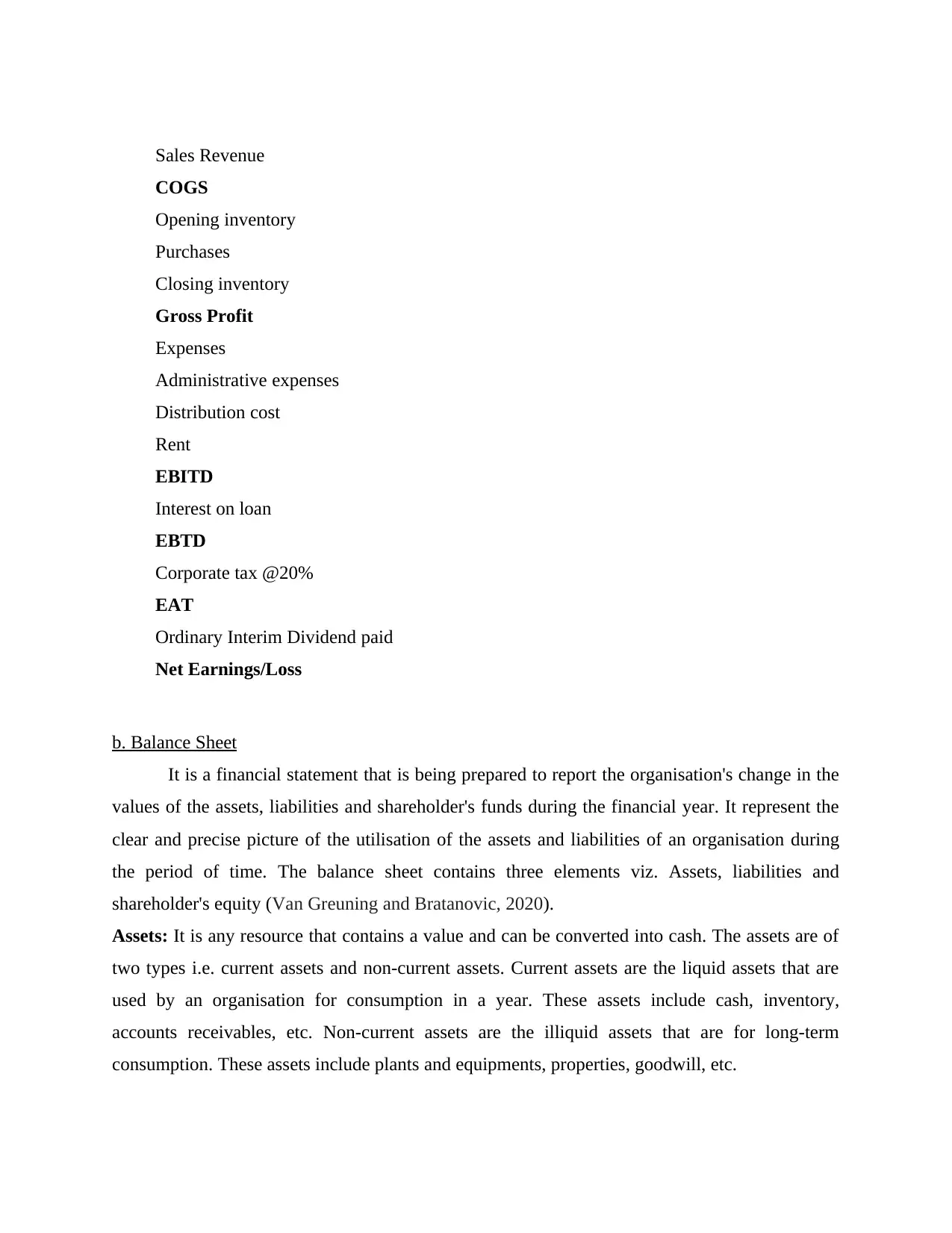
Sales Revenue
COGS
Opening inventory
Purchases
Closing inventory
Gross Profit
Expenses
Administrative expenses
Distribution cost
Rent
EBITD
Interest on loan
EBTD
Corporate tax @20%
EAT
Ordinary Interim Dividend paid
Net Earnings/Loss
b. Balance Sheet
It is a financial statement that is being prepared to report the organisation's change in the
values of the assets, liabilities and shareholder's funds during the financial year. It represent the
clear and precise picture of the utilisation of the assets and liabilities of an organisation during
the period of time. The balance sheet contains three elements viz. Assets, liabilities and
shareholder's equity (Van Greuning and Bratanovic, 2020).
Assets: It is any resource that contains a value and can be converted into cash. The assets are of
two types i.e. current assets and non-current assets. Current assets are the liquid assets that are
used by an organisation for consumption in a year. These assets include cash, inventory,
accounts receivables, etc. Non-current assets are the illiquid assets that are for long-term
consumption. These assets include plants and equipments, properties, goodwill, etc.
COGS
Opening inventory
Purchases
Closing inventory
Gross Profit
Expenses
Administrative expenses
Distribution cost
Rent
EBITD
Interest on loan
EBTD
Corporate tax @20%
EAT
Ordinary Interim Dividend paid
Net Earnings/Loss
b. Balance Sheet
It is a financial statement that is being prepared to report the organisation's change in the
values of the assets, liabilities and shareholder's funds during the financial year. It represent the
clear and precise picture of the utilisation of the assets and liabilities of an organisation during
the period of time. The balance sheet contains three elements viz. Assets, liabilities and
shareholder's equity (Van Greuning and Bratanovic, 2020).
Assets: It is any resource that contains a value and can be converted into cash. The assets are of
two types i.e. current assets and non-current assets. Current assets are the liquid assets that are
used by an organisation for consumption in a year. These assets include cash, inventory,
accounts receivables, etc. Non-current assets are the illiquid assets that are for long-term
consumption. These assets include plants and equipments, properties, goodwill, etc.
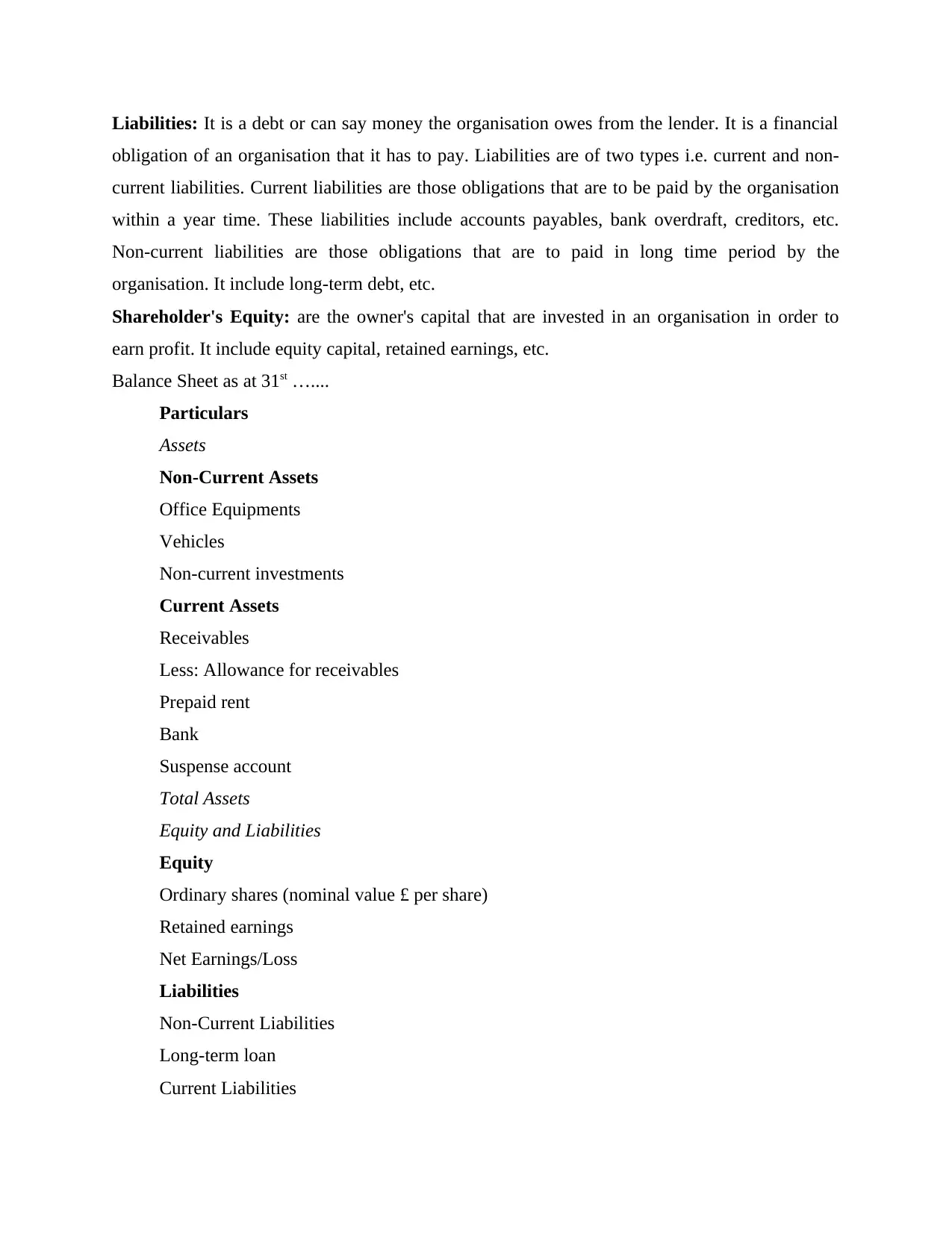
Liabilities: It is a debt or can say money the organisation owes from the lender. It is a financial
obligation of an organisation that it has to pay. Liabilities are of two types i.e. current and non-
current liabilities. Current liabilities are those obligations that are to be paid by the organisation
within a year time. These liabilities include accounts payables, bank overdraft, creditors, etc.
Non-current liabilities are those obligations that are to paid in long time period by the
organisation. It include long-term debt, etc.
Shareholder's Equity: are the owner's capital that are invested in an organisation in order to
earn profit. It include equity capital, retained earnings, etc.
Balance Sheet as at 31st …....
Particulars
Assets
Non-Current Assets
Office Equipments
Vehicles
Non-current investments
Current Assets
Receivables
Less: Allowance for receivables
Prepaid rent
Bank
Suspense account
Total Assets
Equity and Liabilities
Equity
Ordinary shares (nominal value £ per share)
Retained earnings
Net Earnings/Loss
Liabilities
Non-Current Liabilities
Long-term loan
Current Liabilities
obligation of an organisation that it has to pay. Liabilities are of two types i.e. current and non-
current liabilities. Current liabilities are those obligations that are to be paid by the organisation
within a year time. These liabilities include accounts payables, bank overdraft, creditors, etc.
Non-current liabilities are those obligations that are to paid in long time period by the
organisation. It include long-term debt, etc.
Shareholder's Equity: are the owner's capital that are invested in an organisation in order to
earn profit. It include equity capital, retained earnings, etc.
Balance Sheet as at 31st …....
Particulars
Assets
Non-Current Assets
Office Equipments
Vehicles
Non-current investments
Current Assets
Receivables
Less: Allowance for receivables
Prepaid rent
Bank
Suspense account
Total Assets
Equity and Liabilities
Equity
Ordinary shares (nominal value £ per share)
Retained earnings
Net Earnings/Loss
Liabilities
Non-Current Liabilities
Long-term loan
Current Liabilities
⊘ This is a preview!⊘
Do you want full access?
Subscribe today to unlock all pages.

Trusted by 1+ million students worldwide
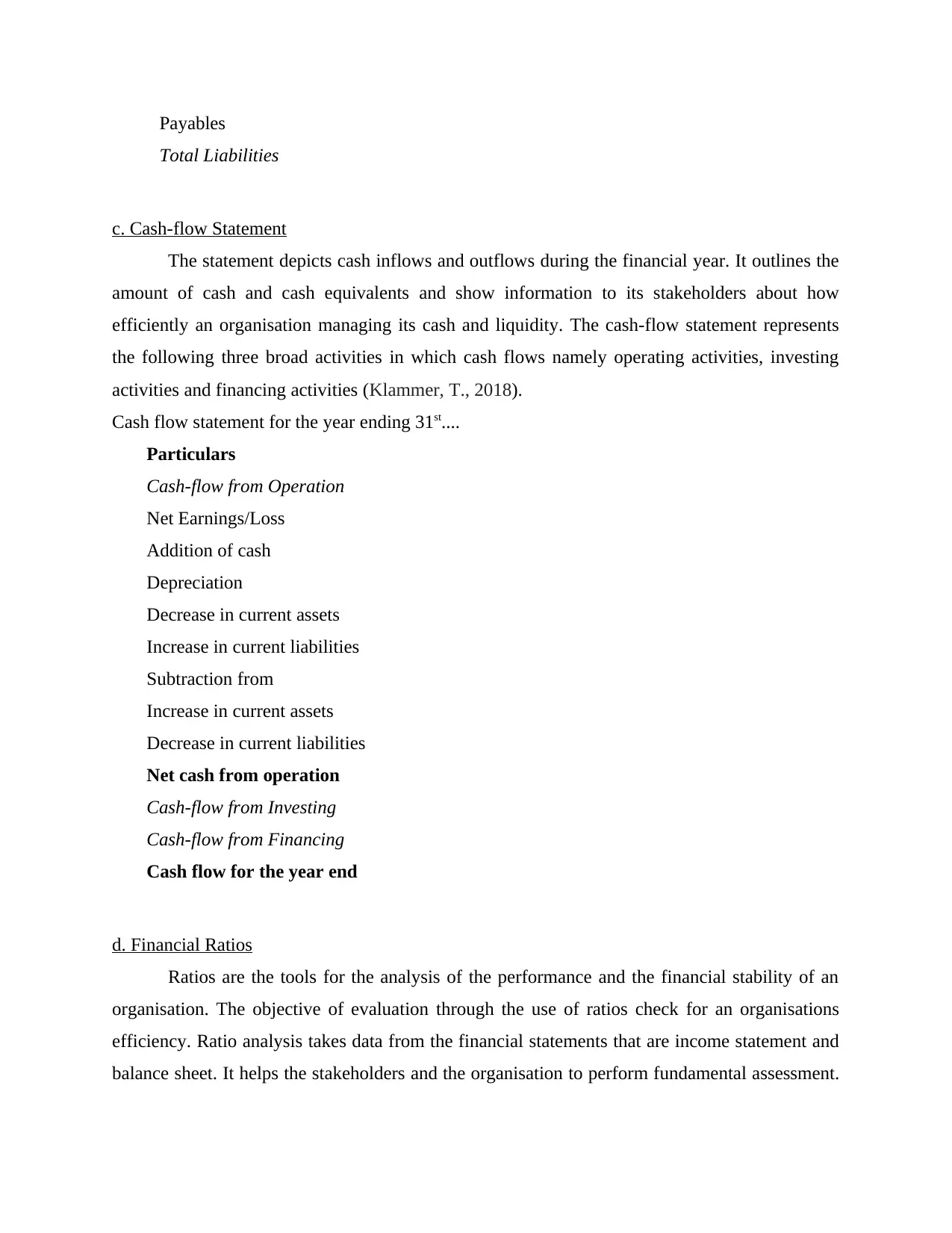
Payables
Total Liabilities
c. Cash-flow Statement
The statement depicts cash inflows and outflows during the financial year. It outlines the
amount of cash and cash equivalents and show information to its stakeholders about how
efficiently an organisation managing its cash and liquidity. The cash-flow statement represents
the following three broad activities in which cash flows namely operating activities, investing
activities and financing activities (Klammer, T., 2018).
Cash flow statement for the year ending 31st....
Particulars
Cash-flow from Operation
Net Earnings/Loss
Addition of cash
Depreciation
Decrease in current assets
Increase in current liabilities
Subtraction from
Increase in current assets
Decrease in current liabilities
Net cash from operation
Cash-flow from Investing
Cash-flow from Financing
Cash flow for the year end
d. Financial Ratios
Ratios are the tools for the analysis of the performance and the financial stability of an
organisation. The objective of evaluation through the use of ratios check for an organisations
efficiency. Ratio analysis takes data from the financial statements that are income statement and
balance sheet. It helps the stakeholders and the organisation to perform fundamental assessment.
Total Liabilities
c. Cash-flow Statement
The statement depicts cash inflows and outflows during the financial year. It outlines the
amount of cash and cash equivalents and show information to its stakeholders about how
efficiently an organisation managing its cash and liquidity. The cash-flow statement represents
the following three broad activities in which cash flows namely operating activities, investing
activities and financing activities (Klammer, T., 2018).
Cash flow statement for the year ending 31st....
Particulars
Cash-flow from Operation
Net Earnings/Loss
Addition of cash
Depreciation
Decrease in current assets
Increase in current liabilities
Subtraction from
Increase in current assets
Decrease in current liabilities
Net cash from operation
Cash-flow from Investing
Cash-flow from Financing
Cash flow for the year end
d. Financial Ratios
Ratios are the tools for the analysis of the performance and the financial stability of an
organisation. The objective of evaluation through the use of ratios check for an organisations
efficiency. Ratio analysis takes data from the financial statements that are income statement and
balance sheet. It helps the stakeholders and the organisation to perform fundamental assessment.
Paraphrase This Document
Need a fresh take? Get an instant paraphrase of this document with our AI Paraphraser
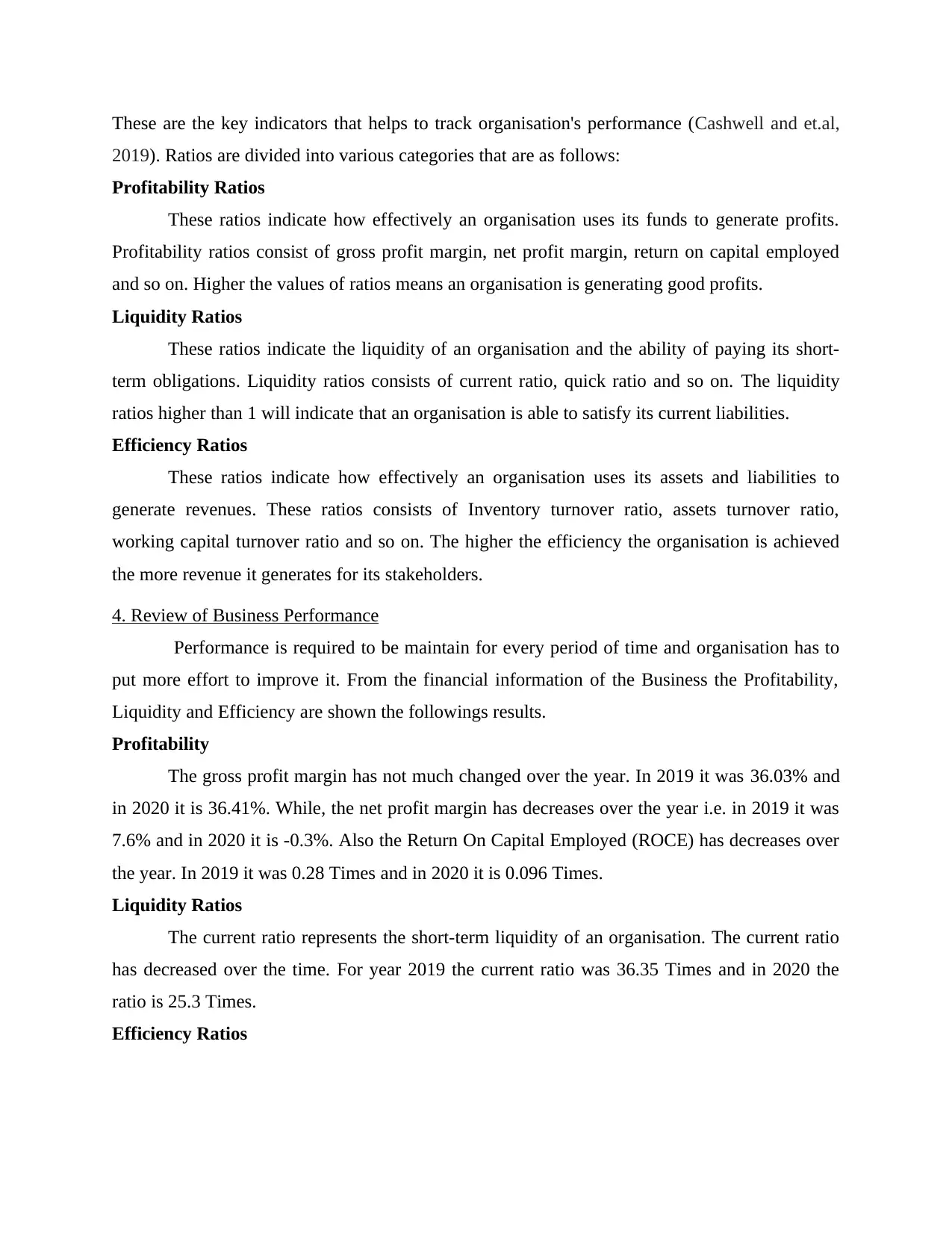
These are the key indicators that helps to track organisation's performance (Cashwell and et.al,
2019). Ratios are divided into various categories that are as follows:
Profitability Ratios
These ratios indicate how effectively an organisation uses its funds to generate profits.
Profitability ratios consist of gross profit margin, net profit margin, return on capital employed
and so on. Higher the values of ratios means an organisation is generating good profits.
Liquidity Ratios
These ratios indicate the liquidity of an organisation and the ability of paying its short-
term obligations. Liquidity ratios consists of current ratio, quick ratio and so on. The liquidity
ratios higher than 1 will indicate that an organisation is able to satisfy its current liabilities.
Efficiency Ratios
These ratios indicate how effectively an organisation uses its assets and liabilities to
generate revenues. These ratios consists of Inventory turnover ratio, assets turnover ratio,
working capital turnover ratio and so on. The higher the efficiency the organisation is achieved
the more revenue it generates for its stakeholders.
4. Review of Business Performance
Performance is required to be maintain for every period of time and organisation has to
put more effort to improve it. From the financial information of the Business the Profitability,
Liquidity and Efficiency are shown the followings results.
Profitability
The gross profit margin has not much changed over the year. In 2019 it was 36.03% and
in 2020 it is 36.41%. While, the net profit margin has decreases over the year i.e. in 2019 it was
7.6% and in 2020 it is -0.3%. Also the Return On Capital Employed (ROCE) has decreases over
the year. In 2019 it was 0.28 Times and in 2020 it is 0.096 Times.
Liquidity Ratios
The current ratio represents the short-term liquidity of an organisation. The current ratio
has decreased over the time. For year 2019 the current ratio was 36.35 Times and in 2020 the
ratio is 25.3 Times.
Efficiency Ratios
2019). Ratios are divided into various categories that are as follows:
Profitability Ratios
These ratios indicate how effectively an organisation uses its funds to generate profits.
Profitability ratios consist of gross profit margin, net profit margin, return on capital employed
and so on. Higher the values of ratios means an organisation is generating good profits.
Liquidity Ratios
These ratios indicate the liquidity of an organisation and the ability of paying its short-
term obligations. Liquidity ratios consists of current ratio, quick ratio and so on. The liquidity
ratios higher than 1 will indicate that an organisation is able to satisfy its current liabilities.
Efficiency Ratios
These ratios indicate how effectively an organisation uses its assets and liabilities to
generate revenues. These ratios consists of Inventory turnover ratio, assets turnover ratio,
working capital turnover ratio and so on. The higher the efficiency the organisation is achieved
the more revenue it generates for its stakeholders.
4. Review of Business Performance
Performance is required to be maintain for every period of time and organisation has to
put more effort to improve it. From the financial information of the Business the Profitability,
Liquidity and Efficiency are shown the followings results.
Profitability
The gross profit margin has not much changed over the year. In 2019 it was 36.03% and
in 2020 it is 36.41%. While, the net profit margin has decreases over the year i.e. in 2019 it was
7.6% and in 2020 it is -0.3%. Also the Return On Capital Employed (ROCE) has decreases over
the year. In 2019 it was 0.28 Times and in 2020 it is 0.096 Times.
Liquidity Ratios
The current ratio represents the short-term liquidity of an organisation. The current ratio
has decreased over the time. For year 2019 the current ratio was 36.35 Times and in 2020 the
ratio is 25.3 Times.
Efficiency Ratios
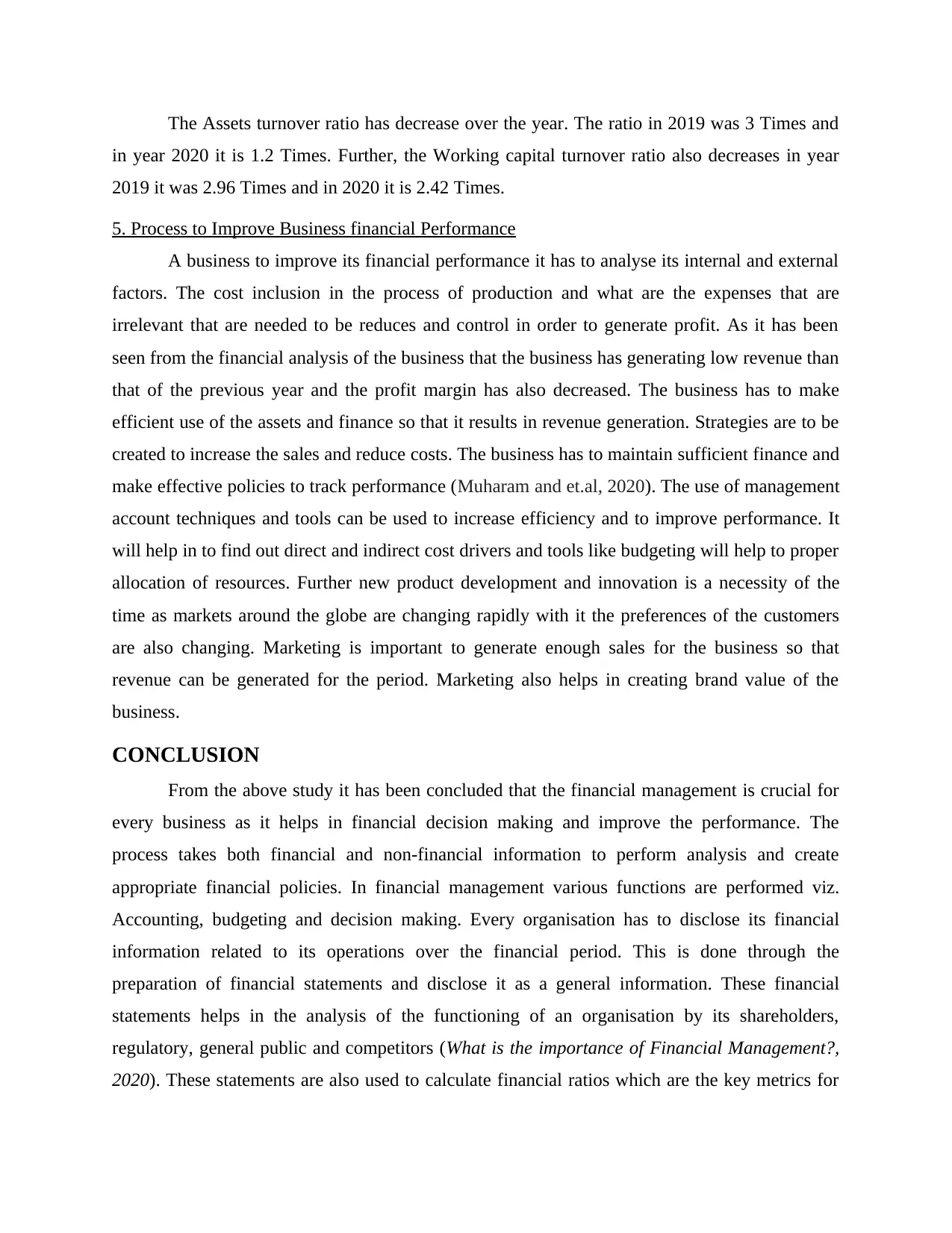
The Assets turnover ratio has decrease over the year. The ratio in 2019 was 3 Times and
in year 2020 it is 1.2 Times. Further, the Working capital turnover ratio also decreases in year
2019 it was 2.96 Times and in 2020 it is 2.42 Times.
5. Process to Improve Business financial Performance
A business to improve its financial performance it has to analyse its internal and external
factors. The cost inclusion in the process of production and what are the expenses that are
irrelevant that are needed to be reduces and control in order to generate profit. As it has been
seen from the financial analysis of the business that the business has generating low revenue than
that of the previous year and the profit margin has also decreased. The business has to make
efficient use of the assets and finance so that it results in revenue generation. Strategies are to be
created to increase the sales and reduce costs. The business has to maintain sufficient finance and
make effective policies to track performance (Muharam and et.al, 2020). The use of management
account techniques and tools can be used to increase efficiency and to improve performance. It
will help in to find out direct and indirect cost drivers and tools like budgeting will help to proper
allocation of resources. Further new product development and innovation is a necessity of the
time as markets around the globe are changing rapidly with it the preferences of the customers
are also changing. Marketing is important to generate enough sales for the business so that
revenue can be generated for the period. Marketing also helps in creating brand value of the
business.
CONCLUSION
From the above study it has been concluded that the financial management is crucial for
every business as it helps in financial decision making and improve the performance. The
process takes both financial and non-financial information to perform analysis and create
appropriate financial policies. In financial management various functions are performed viz.
Accounting, budgeting and decision making. Every organisation has to disclose its financial
information related to its operations over the financial period. This is done through the
preparation of financial statements and disclose it as a general information. These financial
statements helps in the analysis of the functioning of an organisation by its shareholders,
regulatory, general public and competitors (What is the importance of Financial Management?,
2020). These statements are also used to calculate financial ratios which are the key metrics for
in year 2020 it is 1.2 Times. Further, the Working capital turnover ratio also decreases in year
2019 it was 2.96 Times and in 2020 it is 2.42 Times.
5. Process to Improve Business financial Performance
A business to improve its financial performance it has to analyse its internal and external
factors. The cost inclusion in the process of production and what are the expenses that are
irrelevant that are needed to be reduces and control in order to generate profit. As it has been
seen from the financial analysis of the business that the business has generating low revenue than
that of the previous year and the profit margin has also decreased. The business has to make
efficient use of the assets and finance so that it results in revenue generation. Strategies are to be
created to increase the sales and reduce costs. The business has to maintain sufficient finance and
make effective policies to track performance (Muharam and et.al, 2020). The use of management
account techniques and tools can be used to increase efficiency and to improve performance. It
will help in to find out direct and indirect cost drivers and tools like budgeting will help to proper
allocation of resources. Further new product development and innovation is a necessity of the
time as markets around the globe are changing rapidly with it the preferences of the customers
are also changing. Marketing is important to generate enough sales for the business so that
revenue can be generated for the period. Marketing also helps in creating brand value of the
business.
CONCLUSION
From the above study it has been concluded that the financial management is crucial for
every business as it helps in financial decision making and improve the performance. The
process takes both financial and non-financial information to perform analysis and create
appropriate financial policies. In financial management various functions are performed viz.
Accounting, budgeting and decision making. Every organisation has to disclose its financial
information related to its operations over the financial period. This is done through the
preparation of financial statements and disclose it as a general information. These financial
statements helps in the analysis of the functioning of an organisation by its shareholders,
regulatory, general public and competitors (What is the importance of Financial Management?,
2020). These statements are also used to calculate financial ratios which are the key metrics for
⊘ This is a preview!⊘
Do you want full access?
Subscribe today to unlock all pages.

Trusted by 1+ million students worldwide

to know the performance of an organisation. A sample case was presented in this report to show
how these statements are prepared and ratios are calculated. Also the effect of the information
generated through this information is presented. At the end financial management is important
for the organisation as it helps in generate and manage profits and help in organisation's growth.
how these statements are prepared and ratios are calculated. Also the effect of the information
generated through this information is presented. At the end financial management is important
for the organisation as it helps in generate and manage profits and help in organisation's growth.
Paraphrase This Document
Need a fresh take? Get an instant paraphrase of this document with our AI Paraphraser
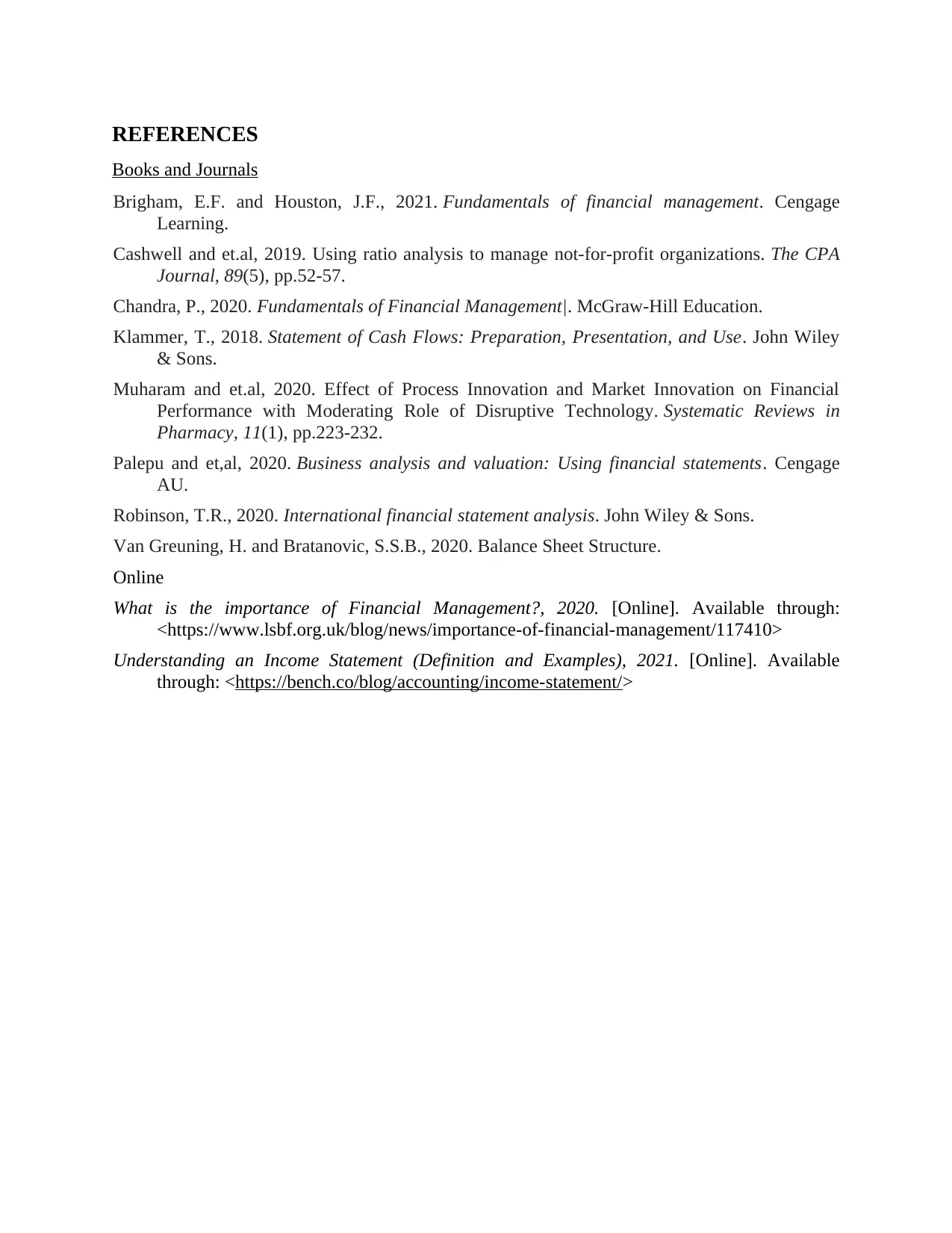
REFERENCES
Books and Journals
Brigham, E.F. and Houston, J.F., 2021. Fundamentals of financial management. Cengage
Learning.
Cashwell and et.al, 2019. Using ratio analysis to manage not-for-profit organizations. The CPA
Journal, 89(5), pp.52-57.
Chandra, P., 2020. Fundamentals of Financial Management|. McGraw-Hill Education.
Klammer, T., 2018. Statement of Cash Flows: Preparation, Presentation, and Use. John Wiley
& Sons.
Muharam and et.al, 2020. Effect of Process Innovation and Market Innovation on Financial
Performance with Moderating Role of Disruptive Technology. Systematic Reviews in
Pharmacy, 11(1), pp.223-232.
Palepu and et,al, 2020. Business analysis and valuation: Using financial statements. Cengage
AU.
Robinson, T.R., 2020. International financial statement analysis. John Wiley & Sons.
Van Greuning, H. and Bratanovic, S.S.B., 2020. Balance Sheet Structure.
Online
What is the importance of Financial Management?, 2020. [Online]. Available through:
<https://www.lsbf.org.uk/blog/news/importance-of-financial-management/117410>
Understanding an Income Statement (Definition and Examples), 2021. [Online]. Available
through: <https://bench.co/blog/accounting/income-statement/>
Books and Journals
Brigham, E.F. and Houston, J.F., 2021. Fundamentals of financial management. Cengage
Learning.
Cashwell and et.al, 2019. Using ratio analysis to manage not-for-profit organizations. The CPA
Journal, 89(5), pp.52-57.
Chandra, P., 2020. Fundamentals of Financial Management|. McGraw-Hill Education.
Klammer, T., 2018. Statement of Cash Flows: Preparation, Presentation, and Use. John Wiley
& Sons.
Muharam and et.al, 2020. Effect of Process Innovation and Market Innovation on Financial
Performance with Moderating Role of Disruptive Technology. Systematic Reviews in
Pharmacy, 11(1), pp.223-232.
Palepu and et,al, 2020. Business analysis and valuation: Using financial statements. Cengage
AU.
Robinson, T.R., 2020. International financial statement analysis. John Wiley & Sons.
Van Greuning, H. and Bratanovic, S.S.B., 2020. Balance Sheet Structure.
Online
What is the importance of Financial Management?, 2020. [Online]. Available through:
<https://www.lsbf.org.uk/blog/news/importance-of-financial-management/117410>
Understanding an Income Statement (Definition and Examples), 2021. [Online]. Available
through: <https://bench.co/blog/accounting/income-statement/>
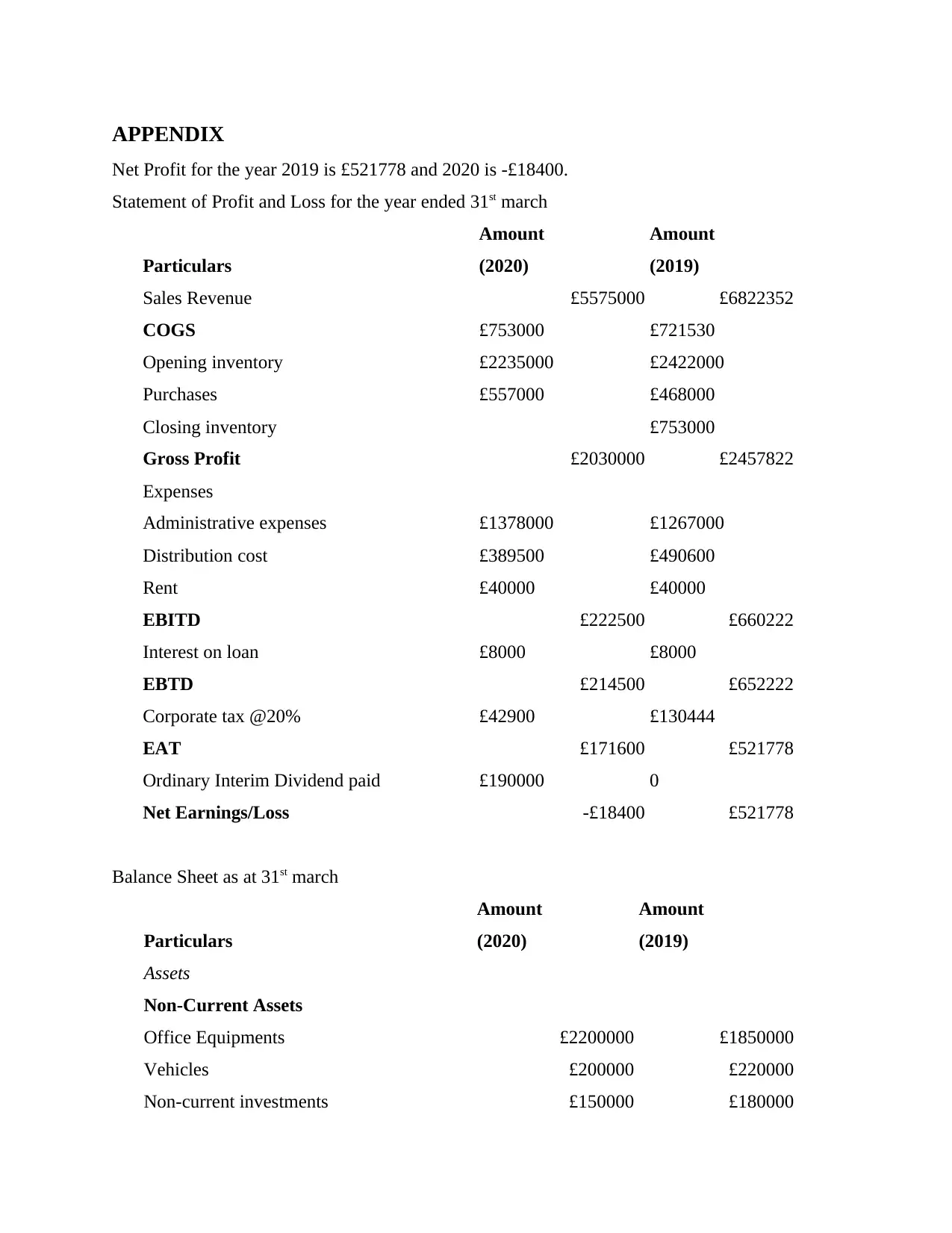
APPENDIX
Net Profit for the year 2019 is £521778 and 2020 is -£18400.
Statement of Profit and Loss for the year ended 31st march
Particulars
Amount
(2020)
Amount
(2019)
Sales Revenue £5575000 £6822352
COGS £753000 £721530
Opening inventory £2235000 £2422000
Purchases £557000 £468000
Closing inventory £753000
Gross Profit £2030000 £2457822
Expenses
Administrative expenses £1378000 £1267000
Distribution cost £389500 £490600
Rent £40000 £40000
EBITD £222500 £660222
Interest on loan £8000 £8000
EBTD £214500 £652222
Corporate tax @20% £42900 £130444
EAT £171600 £521778
Ordinary Interim Dividend paid £190000 0
Net Earnings/Loss -£18400 £521778
Balance Sheet as at 31st march
Particulars
Amount
(2020)
Amount
(2019)
Assets
Non-Current Assets
Office Equipments £2200000 £1850000
Vehicles £200000 £220000
Non-current investments £150000 £180000
Net Profit for the year 2019 is £521778 and 2020 is -£18400.
Statement of Profit and Loss for the year ended 31st march
Particulars
Amount
(2020)
Amount
(2019)
Sales Revenue £5575000 £6822352
COGS £753000 £721530
Opening inventory £2235000 £2422000
Purchases £557000 £468000
Closing inventory £753000
Gross Profit £2030000 £2457822
Expenses
Administrative expenses £1378000 £1267000
Distribution cost £389500 £490600
Rent £40000 £40000
EBITD £222500 £660222
Interest on loan £8000 £8000
EBTD £214500 £652222
Corporate tax @20% £42900 £130444
EAT £171600 £521778
Ordinary Interim Dividend paid £190000 0
Net Earnings/Loss -£18400 £521778
Balance Sheet as at 31st march
Particulars
Amount
(2020)
Amount
(2019)
Assets
Non-Current Assets
Office Equipments £2200000 £1850000
Vehicles £200000 £220000
Non-current investments £150000 £180000
⊘ This is a preview!⊘
Do you want full access?
Subscribe today to unlock all pages.

Trusted by 1+ million students worldwide
1 out of 14
Related Documents
Your All-in-One AI-Powered Toolkit for Academic Success.
+13062052269
info@desklib.com
Available 24*7 on WhatsApp / Email
![[object Object]](/_next/static/media/star-bottom.7253800d.svg)
Unlock your academic potential
Copyright © 2020–2025 A2Z Services. All Rights Reserved. Developed and managed by ZUCOL.

